Accardi L., Freudenberg W., Obya M. (Eds.) Quantum Bio-informatics IV: From Quantum Information to Bio-informatics
Подождите немного. Документ загружается.


This page intentionally left blankThis page intentionally left blank
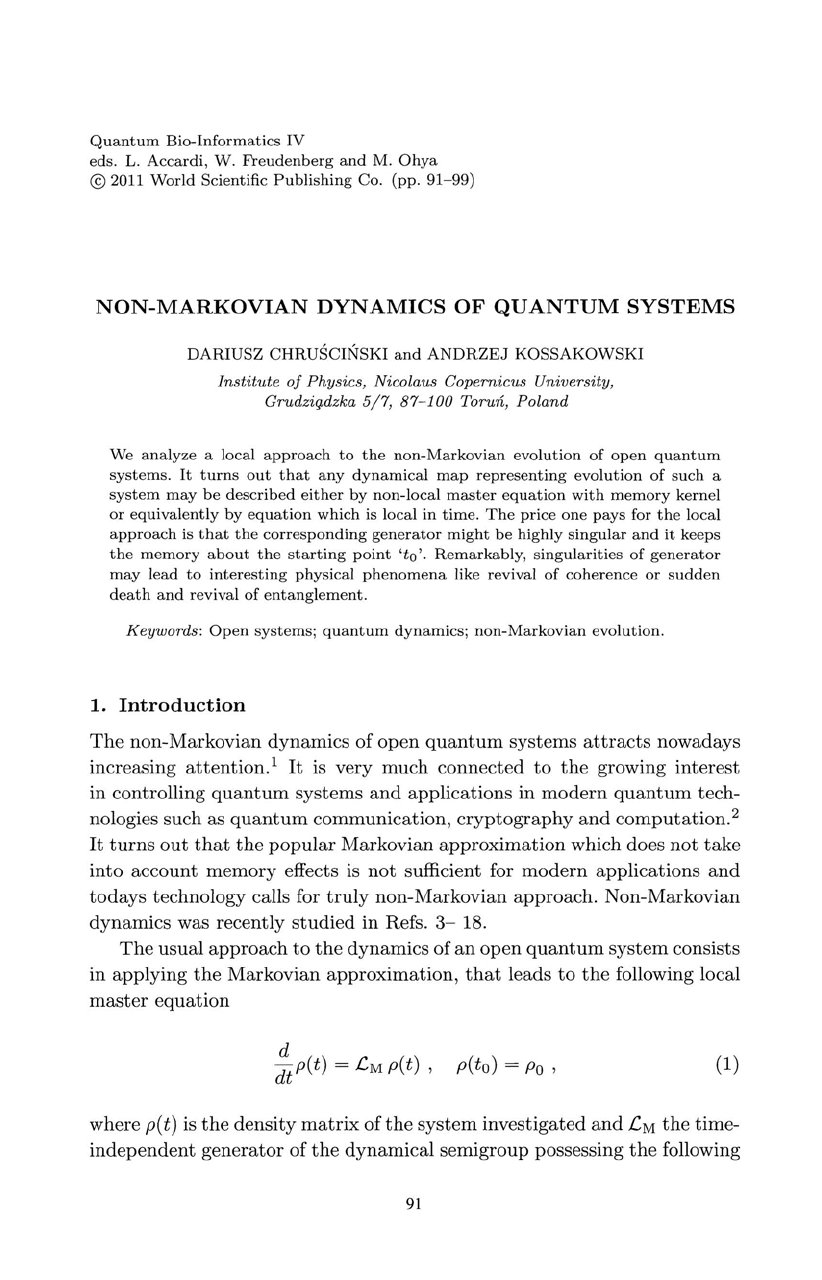
Quantum
Bio-Informatics
IV
eds. L.
Accardi,
W.
Freud
enbe
rg
and
M.
Ohya
© 2011
World
Scientific
Publishing
Co.
(pp.
91
- 99)
NON-MARKOVIAN
DYNAMICS
OF
QUANTUM
SYSTEMS
DARIUSZ
CHRU8CIl\[SKI
and
ANDRZEJ
KOSSAKOWSKI
Institute
of
Physics,
Nicolaus
Copernicus
University,
Grudzig,dzka
5/7,
87-100
Toru'Ti,
Poland
We
analyze
a local
approach
to
the
non-Markovian
evolution
of
open
quantum
systems.
It
turns
out
that
any
dynamical
map
repres
e
nting
evolution
of
such
a
system
may
be
described
either
by
non-loc
al
master
equation
with
memory
kernel
or
equival
e
ntly
by
equation
which
is
local
in
time.
The
price
one
pays
for
the
local
approach
is
that
the
corresponding
generator
might
be
highly
singular
and
it
keeps
the
memory
about
th
e
starting
point
'to'.
Remarkably,
singularities
of
generator
may
lead
to
interesting
physical
phenomen
a like
revival
of
coherence
or
sudden
death
and
revival
of
entanglement.
Keywords:
Open
systems;
quantum
dynamics;
non-Markovian
evolution.
1.
Introduction
The
non-Markovian dynamics of
open
quantum
systems
attracts
nowadays
increasing
attention.
1
It
is very
much
connected
to
the
growing
interest
in
controlling
quantum
systems
and
applications in
modern
quantum
tech-
nologies such as
quantum
communication,
cryptography
and
computation.
2
It
turns
out
that
the
popular
Markovian
approximation
which does
not
take
into account
memory
effects is
not
sufficient for
modern
applications
and
to
days technology calls for
truly
non-Markovian approach. Non-Markovian
dynamics was recently
studied
in Refs. 3- 18.
The
usual
approach
to
the
dynamics
of
an
open
quantum
syst
em
consists
in
applying
the
Markovian approximation,
that
leads
to
the
following local
master
equation
d
dtP(t) = .eMP(t) , p(to) = Po,
(1)
where p(t) is
the
density
matrix
ofthe
system
investigated
and.e
M
the
time-
independent
generator
of
the
dynamical
semigroup possessing
the
following
91
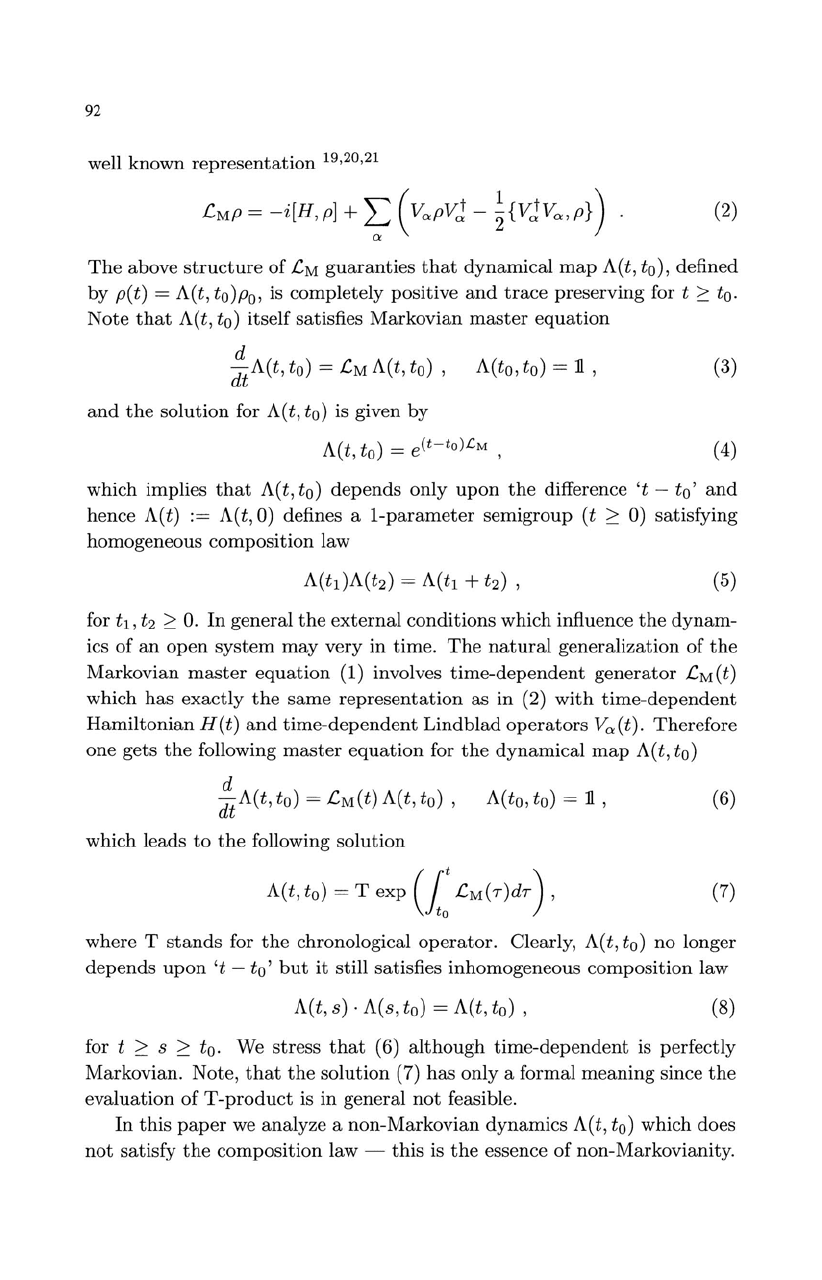
92
well known
representation
19
,
20,21
LMP= -i[H,p] + L (VaPVd -
~{VdVa,p})
'"
(2)
The
above
structure
of
LM
guaranties
that
dynamical
map
A(t, to), defined
by
p(t) = A(t,
to)Po,
is completely positive
and
trace
preserving for t
2:
to·
Note
that
A(t,
to)
itself satisfies Markovian
master
equation
d
dt A(t,
to)
=
LM
A(t,
to),
A(to,to) = ] ,
(3)
and
the
solution for A(t,
to)
is given by
A(t,
to)
=
e(t
-
tO)LM
,
(4)
which implies
that
A(t,
to)
depends
only
upon
the
difference 't - to'
and
hence A(t)
:=
A(t,O) defines a
I-parameter
semi
group
(t
2:
0) satisfying
homogeneous composition law
(5)
for t1, t2
2:
O.
In general
the
external
conditions which influence
the
dynam-
ics
of
an
open
system
may
very
in
time.
The
natural
generalization
of
the
Markovian
master
equation
(1)
involves
time-dependent
generator
LM(t)
which
has
exactly
the
same
representation
as in (2)
with
time-dependent
Hamiltonian
H(t)
and
time-dependent
Lindblad
operators
V",(t). Therefore
one gets
the
following
master
equation
for
the
dynamical
map
A(t,
to)
d
dt
A(t, to) = LM(t) A(t,
to),
A(to, to) = ] ,
(6)
which leads
to
the
following solution
A(t,
to)
= T exp
(1:
LM(T)dT) ,
(7)
where T
stands
for
the
chronological
operator.
Clearly, A(t,
to)
no longer
depends
upon
't - to'
but
it
still satisfies inhomogeneous composition law
A(t,s)·A(s,to)
= A(t,
to)
,
(8)
for t
2:
s
2:
to.
We stress
that
(6)
although
time-dependent
is perfectly
Markovian. Note,
that
the
solution (7)
has
only a formal
meaning
since
the
evaluation
of
T-product
is
in
general
not
feasible.
In
this
paper
we analyze a non-Markovian dynamics A(t,
to)
which does
not
satisfy
the
composition law -
this
is
the
essence
of
non-Markovianity.
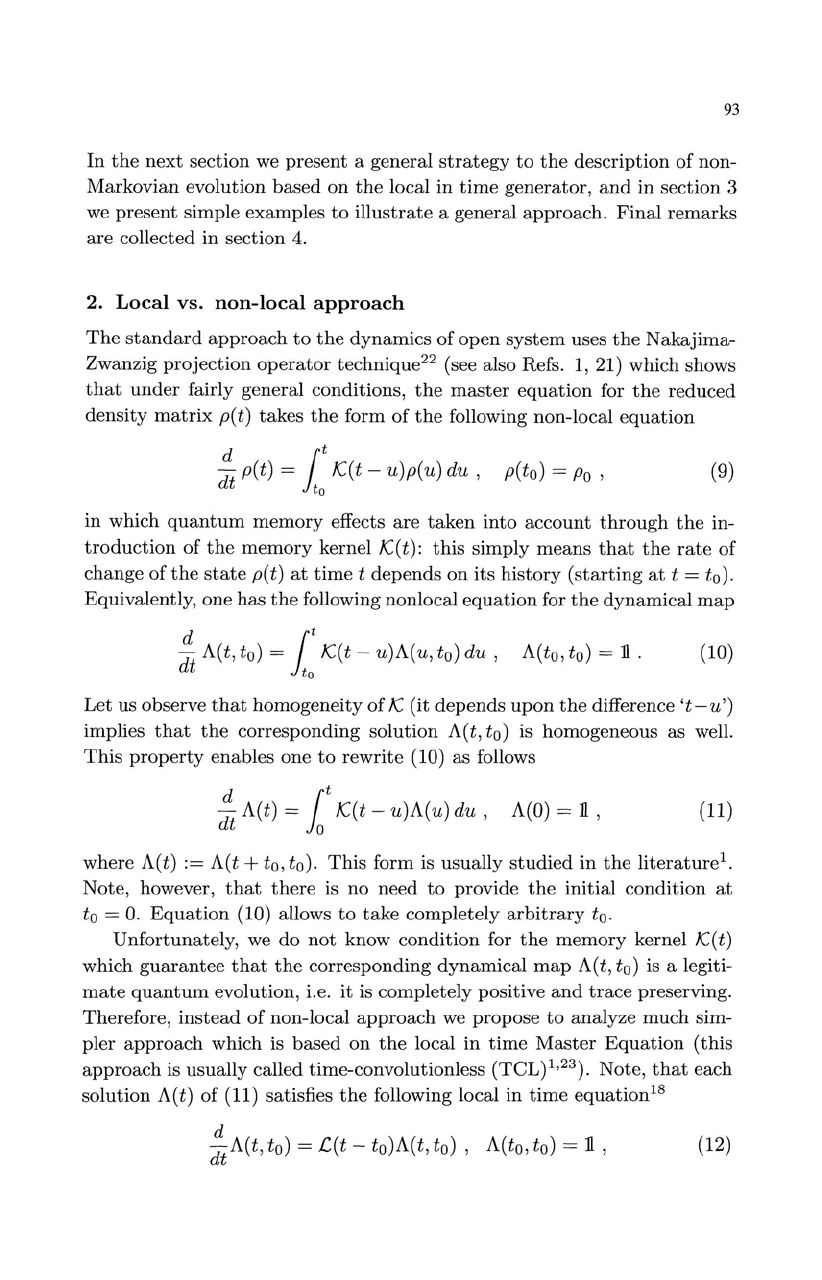
93
In
the
next
section
we
present a general
strategy
to
the
description
of
non-
Markovian evolution
based
on
the
local
in
time
generator,
and
in
section 3
we
present
simple examples
to
illustrate
a general approach.
Final
remarks
are collected in section 4.
2.
Local
vs.
non-local
approach
The
standard
approach
to
the
dynamics
of
open
system
uses
the
Nakajima-
Zwanzig
projection
operator
technique
22
(see also Refs.
1,
21) which shows
that
under
fairly general conditions,
the
master
equation
for
the
reduced
density
matrix
pet)
takes
the
form
of
the
following non-local
equation
d
it
-d
pet)
= K(t - u)p(u) du ,
t
to
p(to) =
Po
,
(9)
in
which
quantum
memory
effects
are
taken
into
account
through
the
in-
troduction
of
the
memory
kernel K(t):
this
simply
means
that
the
rate
of
change
of
the
state
pet)
at
time
t
depends
on
its
history
(starting
at
t = to).
Equivalently,
one
has
the
following nonlocal
equation
for
the
dynamical
map
d
it
-d
A(t,
to)
= Ket - u)A(u,
to)
du ,
t to
A(to,
to)
= n .
(10)
Let
us observe
that
homogeneity
of
K (it
depends
upon
the
difference
't-u')
implies
that
the
corresponding
solution
A(t,
to)
is homogeneous as well.
This
property
enables one
to
rewrite
(10)
as follows
d
t
dt A(t) =
Jo
Ket - u)A(u) du ,
A(O)
= n ,
(11)
where
A(t)
:=
A(t +
to,
to).
This
form is usually
studied
in
the
literature
1
.
Note, however,
that
there
is no need
to
provide
the
initial
condition
at
to
=
o.
Equation
(10)
allows
to
take
completely
arbitrary
to.
Unfortunately, we
do
not
know
condition
for
the
memory
kernel K(t)
which
guarantee
that
the
corresponding
dynamical
map
A(t,
to)
is a legiti-
mate
quantum
evolution, i.e.
it
is completely positive
and
trace
preserving.
Therefore,
instead
of
non-local
approach
we propose
to
analyze
much
sim-
pler
approach
which is
based
on
the
local
in
time
Master
Equation
(this
approach
is usually called time-convolutionless (TCL)1,23). Note,
that
each
solution A(t)
of
(11) satisfies
the
following local in
time
equation
18
d
dt A(t,
to)
=
L(t
- to)A(t,
to),
A(to,
to)
= n ,
(12)
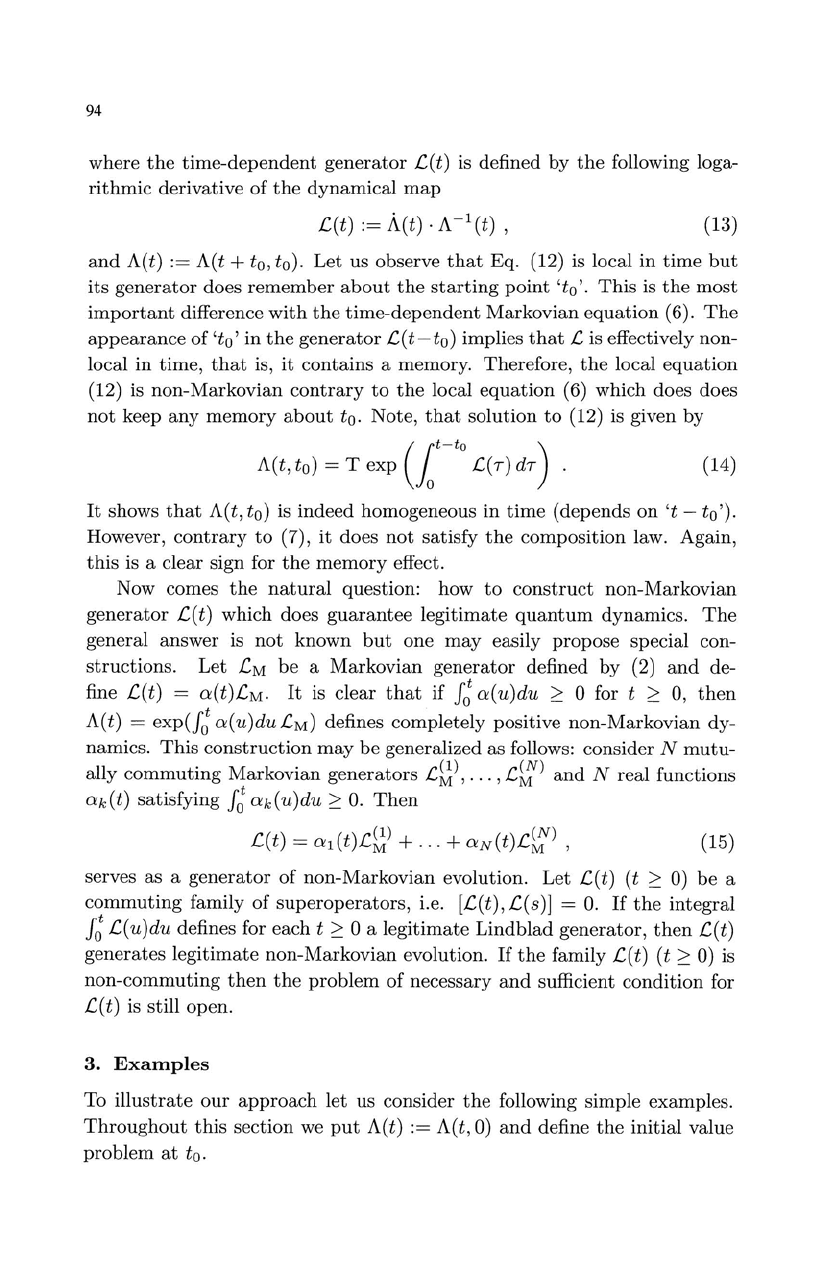
94
where
the
time-dependent
generator
£(t)
is defined
by
the
following loga-
rithmic
derivative of
the
dynamical
map
(13)
and
A(t)
:=
A(t
+
to,
to).
Let
us observe
that
Eq. (12) is local
in
time
but
its
generator
does
remember
about
the
starting
point
'to'.
This
is
the
most
important
difference
with
the
time-dependent
Markovian
equation
(6).
The
appearance
of 'to'
in
the
generator
£(t-t
o
)
implies
that
£ is effectively non-
local in
time,
that
is,
it
contains
a memory. Therefore,
the
local
equation
(12) is non-Markovian
contrary
to
the
local
equation
(6) which does does
not
keep
any
memory
about
to.
Note,
that
solution
to
(12) is given by
A(t,
to)
= T
exp
(fat-to
£(T) dT) .
(14)
It
shows
that
A(t,
to)
is indeed homogeneous in
time
(depends
on
't - to').
However,
contrary
to
(7),
it
does
not
satisfy
the
composition
law. Again,
this
is a clear sign for
the
memory
effect.
Now comes
the
natural
question: how
to
construct
non-Markovian
generator
£(t)
which does
guarantee
legitimate
quantum
dynamics.
The
general answer is
not
known
but
one
may
easily propose special con-
structions.
Let
£M
be
a
Markovian
generator
defined
by
(2)
and
de-
fine
£(t)
= a(t)£M'
It
is clear
that
if
J~
a(u)du
:2:
0 for t
:2:
0,
then
A(t) =
exp(J~
a(u)du£M)
defines completely positive non-Markovian dy-
namics.
This
construction
may
be
generalized as follows: consider N
mutu-
ally
commuting
Markovian
generators
£~),
...
,£r/)
and
N real functions
ak(t) satisfying
J~
ak(u)du
:2:
O.
Then
r(
) ( )
r(1)
( )
rCN)
J..-
t =
a1
t
J..-M
+ ... +
aN
t
J..-M
,
(15)
serves
as
a
generator
of
non-Markovian evolution.
Let
£(t)
(t
:2:
0)
be
a
commuting
family
of
superoperators,
i.e. [£(t),£(s)] =
O.
If
the
integral
J~
£(u)du
defines for each t
:2:
0 a
legitimate
Lindblad
generator,
then
£(t)
generates
legitimate
non-Markovian evolution.
If
the
family
£(t)
(t
:2:
0)
is
non-commuting
then
the
problem
of necessary
and
sufficient
condition
for
£
(t)
is still open.
3.
Examples
To
illustrate
our
approach
let us consider
the
following simple examples.
Throughout
this
section
we
put
A(t)
:=
A(t, 0)
and
define
the
initial value
problem
at
to.
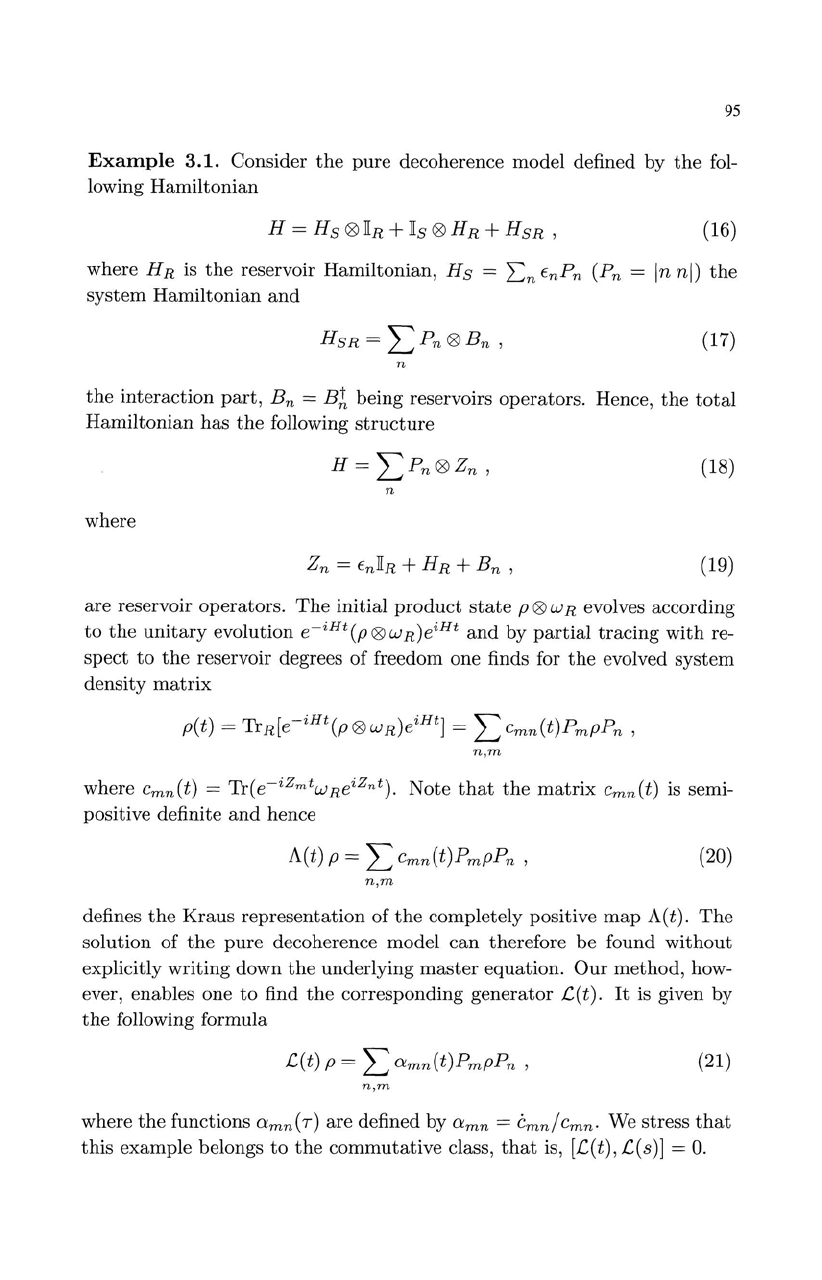
95
Example
3.1.
Consider
the
pure
decoherence
model
defined
by
the
fol-
lowing
Hamiltonian
(16)
where HR is
the
reservoir
Hamiltonian,
Hs
=
Ln
EnP
n
(P
n
=
In
nl)
the
system
Hamiltonian
and
(17)
the
interaction
part,
Bn
=
B~
being reservoirs
operators.
Hence,
the
total
Hamiltonian
has
the
following
structure
(18)
n
where
(19)
are
reservoir
operators.
The
initial
product
state
p ® W R evolves according
to
the
unitary
evolution
e-
iHt
(p
® W
R)e
iHt
and
by
partial
tracing
with
re-
spect
to
the
reservoir degrees
of
freedom one finds for
the
evolved
system
density
matrix
n,m
where cmn(t)
=
Tr(e-iz=twReiZnt).
Note
that
the
matrix
cmn(t) is semi-
positive definite
and
hence
(20)
n,m
defines
the
Kraus
representation
of
the
completely positive
map
A(t).
The
solution
of
the
pure
de coherence
model
can
therefore
be
found
without
explicitly
writing
down
the
underlying
master
equation.
Our
method,
how-
ever, enables one
to
find
the
corresponding
generator
L(t).
It
is given
by
the
following formula
(21)
n,m
where
the
functions
amn(T)
are
defined
by
a
mn
=
cmn/c
mn
. We
stress
that
this
example
belongs
to
the
commutative
class,
that
is, [L(t), L(s)] =
O.
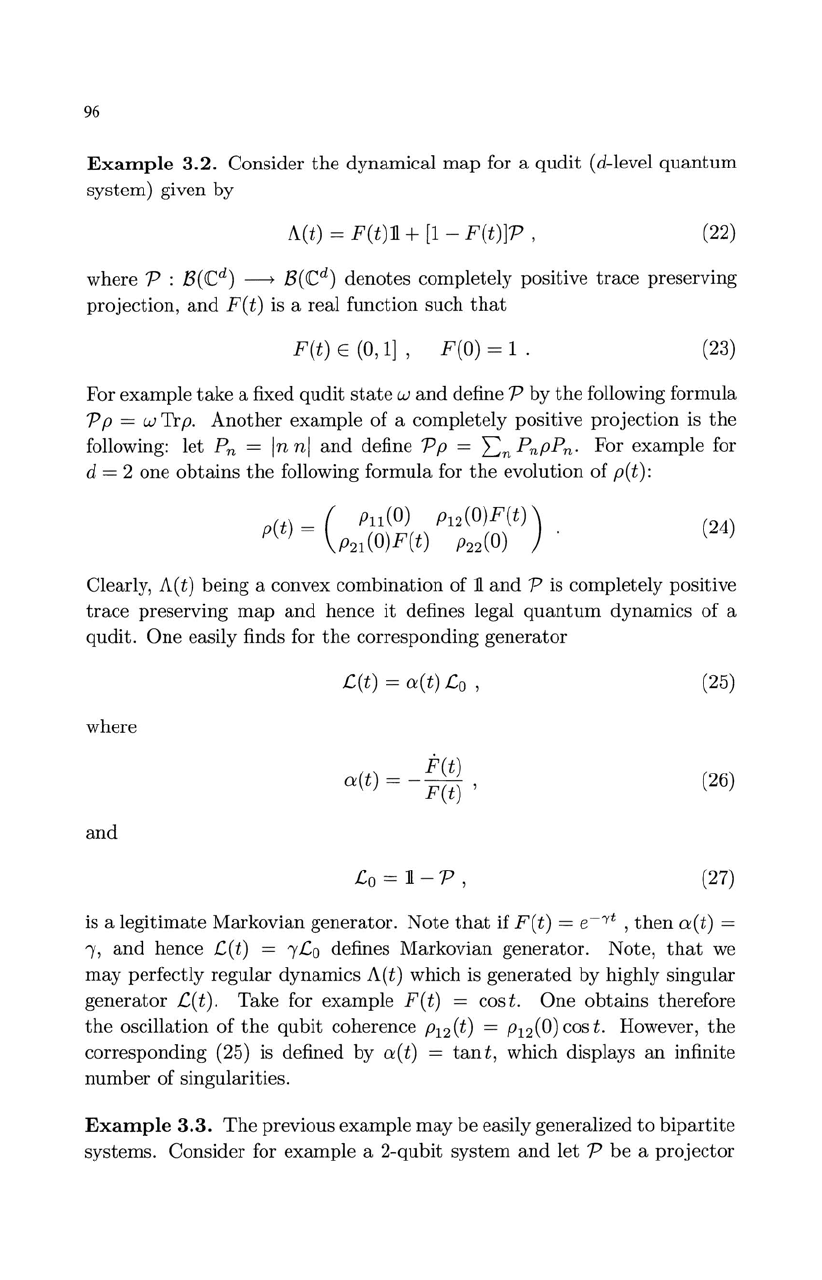
96
Example
3.2.
Consider
the
dynamical
map
for a
qudit
(d-Ievel
quantum
system) given by
A(t) = F(t)ll +
[1
- F(t)]1' ,
(22)
where
l'
: B(C
d
)
-------
B(C
d
)
denotes completely positive
trace
preserving
projection,
and
F(t) is a real function such
that
F(t) E
(0,1],
F(O)
= 1 .
(23)
For example
take
a fixed
qudit
state
wand
define
l'
by
the
following formula
l'
P = w Trp.
Another
example
of
a completely positive
projection
is
the
following: let P
n
=
In
nl
and
define
1'p
=
2:n
PnpP
n
. For example for
d = 2 one
obtains
the
following formula for
the
evolution
of
p(t):
P(t)-(
Pu(O) P12(0)F(t))
-
P21
(O)F(
t)
P22
(0)
.
(24)
Clearly, A(t) being a convex
combination
of
II
and
l'
is completely positive
trace
preserving
map
and
hence
it
defines legal
quantum
dynamics
of
a
qudit
.
One
easily finds for
the
corresponding
generator
where
and
.c(t) =
a(t).c
o
,
F(t)
a(t)
= - F(t) ,
.co
=
II
-1'
,
(25)
(26)
(27)
is a legitimate Markovian generator.
Note
that
if F(t) =
e-,t
,
then
a(t) =
"
and
hence .c(t) = ,.co defines Markovian generator. Note,
that
we
may
perfectly regular dynamics A(t) which is
generated
by highly singular
generator
.c(t). Take for example F(t) = cost. One
obtains
therefore
the
oscillation
of
the
qubit
coherence
P12(t)
=
P12(0)
cos t. However,
the
corresponding (25) is defined by a(t) =
tan
t, which displays
an
infinite
number
of singularities.
Example
3.3.
The
previous example
may
be
easily generalized
to
bipartite
systems. Consider for example a 2-qubit
system
and
let
l'
be
a
projector
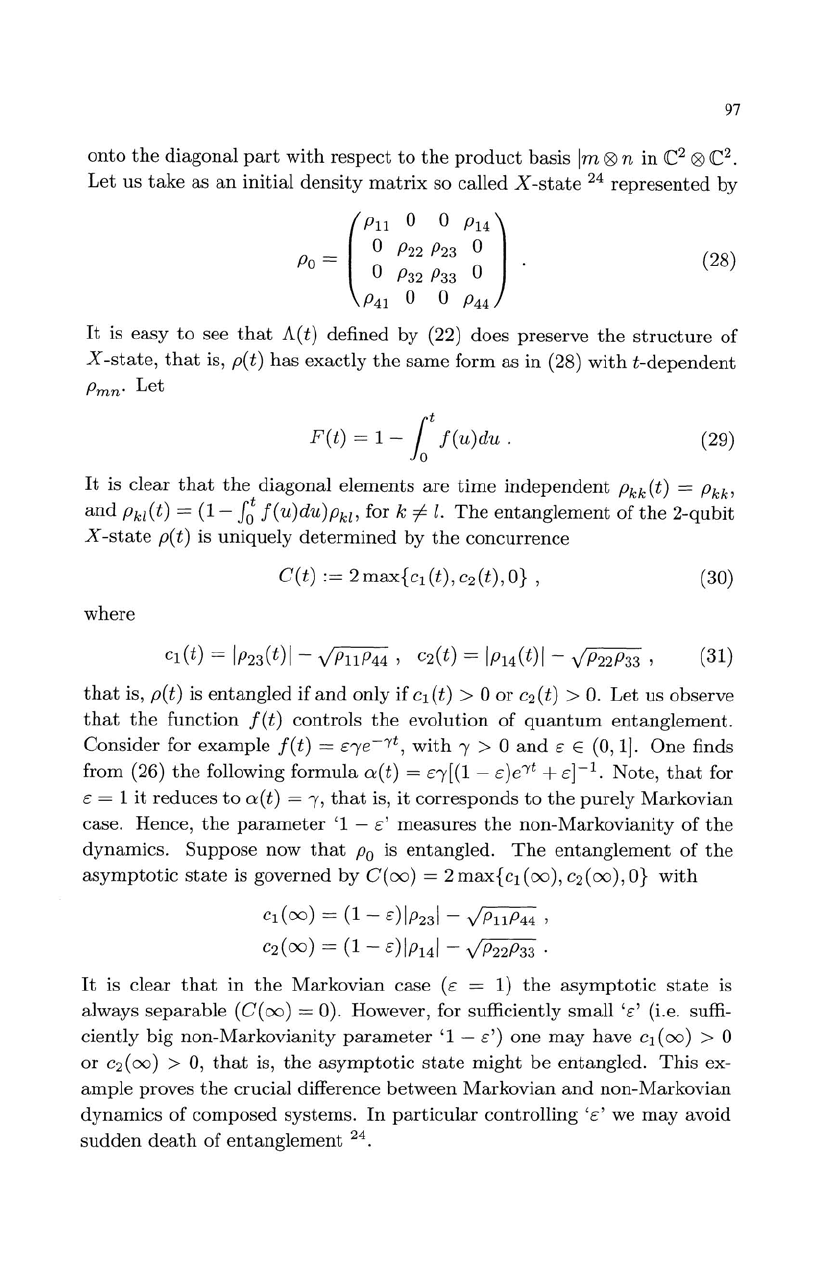
97
onto
the
diagonal
part
with
respect
to
the
product
basis
1m
(9
n
in
((:2
(9
((:2.
Let
us
take
as
an
initial density
matrix
so called X
-state
24
represented by
Po
=
(P~l
P~2 P~3
P~4)
.
o
P32 P33
0
P41
0 0
P44
(28)
It
is easy
to
see
that
A(t) defined by (22) does preserve
the
structure
of
X-state,
that
is, p(t)
has
exactly
the
same
form as
in
(28)
with
t-dependent
P
mn
. Let
F(t) = 1
-lot
f(u)du
.
(29)
It
is clear
that
the
t
diagonal elements
are
time
independent
Pkk(t) =
Pk~'
and
Pkl(t) =
(1-
fa
f(u)du)Pkl' for k
=1-1.
The
entanglement
of
the
2-qublt
X-state
p(t) is uniquely
determined
by
the
concurrence
C (t) : = 2
max
{
Cl
(t),
C2
(t),
O}
,
(30)
where
Cl(t)
=
Ip23(t)l-
VPllP44 ,
C2(t)
=
IP14(t)l-
VP22P33
,
(31)
that
is,
p(
t) is
entangled
if
and
only if
Cl
(t) > 0
or
C2
(t) >
O.
Let us observe
that
the
function
f(t)
controls
the
evolution
of
quantum
entanglement.
Consider for example
f(t)
=
qe-,t,
with
'Y
> 0
and
E E (0,1]. One finds
from (26)
the
following formula a(t) =
q[(l
-
E)e
lt
+
E]-l.
Note,
that
for
E = 1
it
reduces
to
a(t) =
'Y,
that
is,
it
corresponds
to
the
purely
Markovian
case. Hence,
the parameter
'1 -
E'
measures
the
non-Markovianity
of
the
dynamics. Suppose now
that
Po
is entangled.
The
entanglement
of
the
asymptotic
state
is governed by C(oo) =
2max{cdoo),
C2(00),
O}
with
Cl(oo) =
(1-
E)lp231- VPllP44 ,
C2(00)
=
(1
- E)lp141-
VP22P33
.
It
is clear
that
in
the
Markovian case
(E
=
1)
the
asymptotic
state
is
always separable
(C(oo) = 0). However, for sufficiently small
'E'
(i.e. suffi-
ciently big non-Markovianity
parameter
'1 -
E')
one
may
have
Cl
(00) > 0
or
C2(00)
>
0,
that
is,
the
asymptotic
state
might
be
entangled.
This
ex-
ample proves
the
crucial difference between Markovian
and
non-Markovian
dynamics
of
composed systems.
In
particular
controlling
'E'
we
may
avoid
sudden
death
of
entanglement
24.
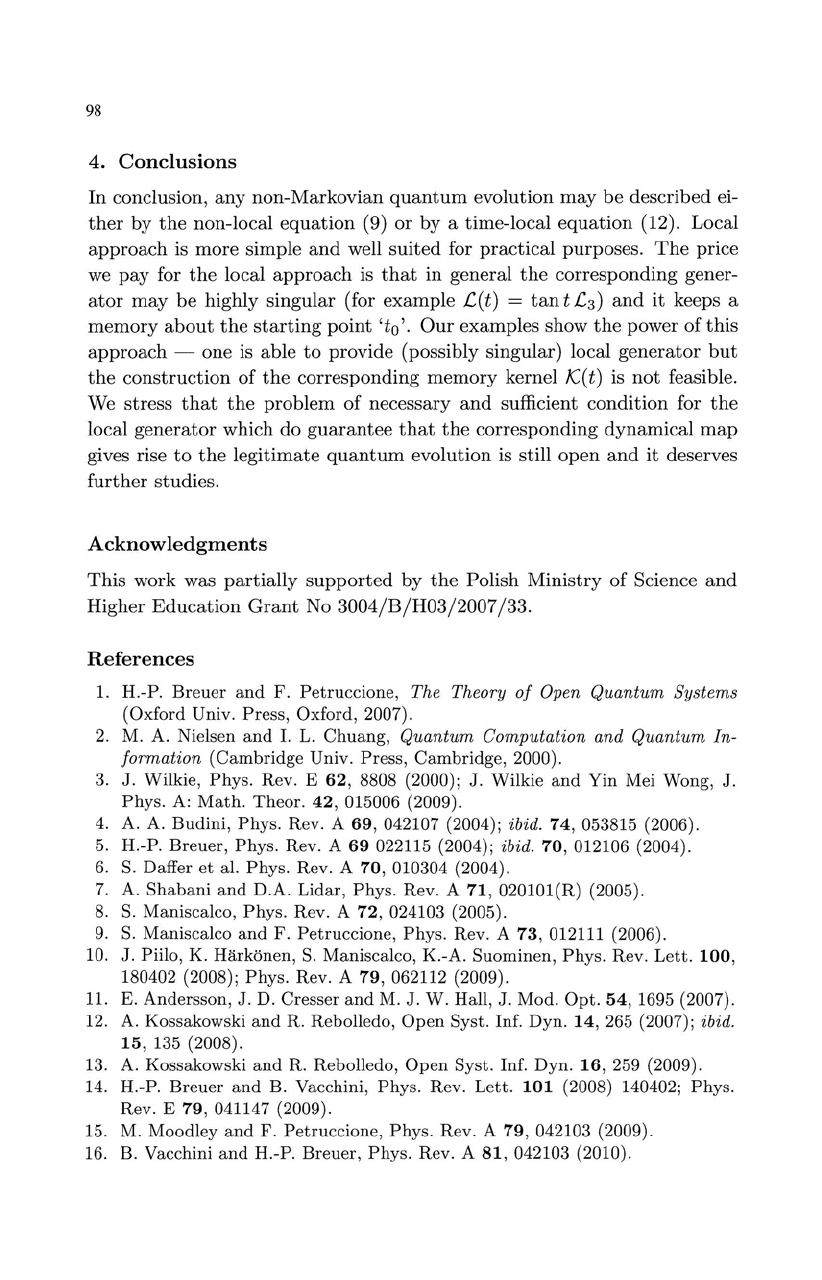
98
4.
Conclusions
In
conclusion,
any
non-Markovian
quantum
evolution
may
be
described
ei-
ther
by
the
non-local
equation
(9)
or
by
a
time-local
equation
(12).
Local
approach
is
more
simple
and
well
suited
for
practical
purposes.
The
price
we
pay
for
the
local
approach
is
that
in
general
the
corresponding
gener-
ator
may
be
highly
singular
(for
example
£(t)
=
tan
t £3)
and
it
keeps a
memory
about
the
starting
point
'to'.
Our
examples
show
the
power
of
this
approach
-
one
is
able
to
provide
(possibly
singular)
local
generator
but
the
construction
of
the
corresponding
memory
kernel K(t) is
not
feasible.
We
stress
that
the
problem
of
necessary
and
sufficient
condition
for
the
local
generator
which
do
guarantee
that
the
corresponding
dynamical
map
gives rise
to
the
legitimate
quantum
evolution
is
still
open
and
it
deserves
further
studies.
Acknowledgments
This
work
was
partially
supported
by
the
Polish
Ministry
of
Science
and
Higher
Education
Grant
No
3004/B/H03/2007/33.
References
1.
H.-P.
Breuer
and
F.
Petruccione,
The Theory
of
Open Quantum
Systems
(Oxford Univ. Press, Oxford, 2007).
2.
M.
A. Nielsen
and
I.
L.
Chuang,
Quantum
Computation and Quantum In-
formation
(Cambridge
Univ. Press,
Cambridge,
2000).
3. J. Wilkie,
Phys.
Rev. E
62,
8808 (2000); J. Wilkie
and
Yin
Mei Wong, J.
Phys.
A:
Math.
Theor.
42,
015006 (2009).
4.
A. A.
Budini,
Phys.
Rev. A
69,
042107 (2004); ibid.
74,
053815 (2006).
5. H.-P.
Breuer,
Phys.
Rev. A
69
022115 (2004); ibid.
70,012106
(2004).
6.
S.
Daffer
et
al.
Phys.
Rev. A
70,
010304 (2004).
7.
A.
Shabani
and
D.A. Lidar,
Phys.
Rev. A
71,
020101(R) (2005).
8.
S.
Maniscalco,
Phys.
Rev. A
72,
024103 (2005).
9.
S.
Maniscalco
and
F.
Petruccione,
Phys.
Rev. A
73,
012111 (2006).
10.
J.
Piilo, K.
Harkonen,
S.
Maniscalco, K.-A. Suominen,
Phys.
Rev.
Lett.
100,
180402 (2008);
Phys.
Rev. A
79,
062112 (2009).
11. E. Andersson, J. D. Cresser
and
M. J.
W.
Hall, J. Mod.
Opt.
54,
1695 (2007).
12. A. Kossakowski
and
R. Rebolledo,
Open
Syst. Inf. Dyn.
14,
265 (2007); ibid.
15,
135 (2008).
13. A. Kossakowski
and
R. Rebolledo,
Open
Syst. Inf. Dyn.
16,
259 (2009).
14. H.-P.
Breuer
and
B. Vacchini,
Phys.
Rev.
Lett.
101
(2008) 140402; Phys.
Rev. E
79,
041147 (2009).
15. M.
Moodley
and
F.
Petruccione,
Phys.
Rev. A
79,
042103 (2009).
16. B. Vacchini
and
H.-P.
Breuer,
Phys.
Rev. A
81,
042103 (2010).
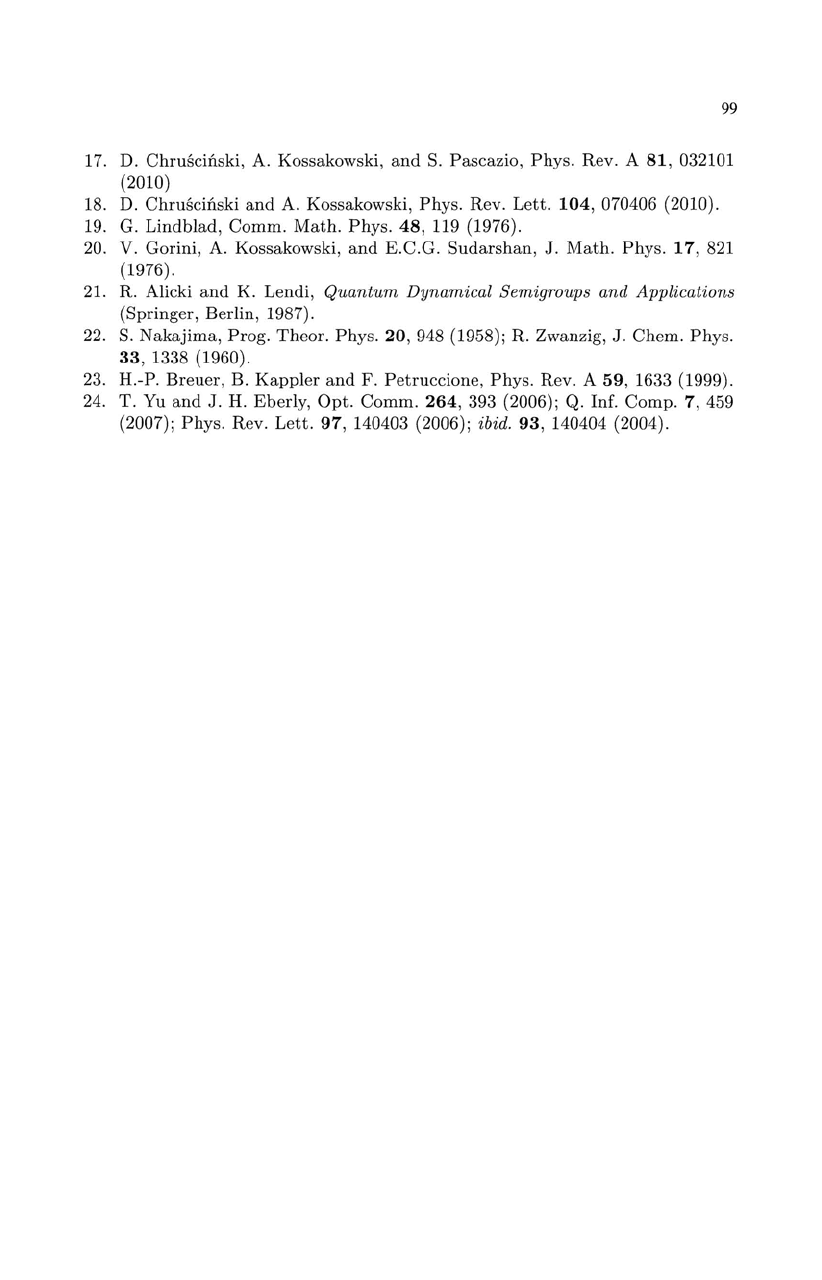
99
17. D. Chruscinski, A. Kossakowski,
and
S.
Pascazio,
Phys.
Rev. A
81,
032101
(2010)
18. D. Chruscinski
and
A. Kossakowski,
Phys.
Rev.
Lett
.
104,070406
(2010).
19. G.
Lindblad,
Comm.
Math.
Phys.
48,
119 (1976).
20. V. Gorini, A. Kossakowski,
and
E.C.G
.
Sudarshan,
J.
Math.
Phys.
17
, 821
(1976).
21. R. Alicki
and
K.
Lendi,
Quantum
Dynamical Semigroups and Applications
(Springer, Berlin, 1987).
22.
S.
Nakajima,
Prog.
Theor.
Phys.
20
, 948 (1958);
R.
Zwanzig, J.
Ch
ern. Phys.
33,
1338 (1960).
23. H.-P. Breuer, B.
Kappler
and
F.
Petruccione,
Phys.
Rev. A
59,1633
(1999).
24.
T.
Yu
and
J.
H.
Eb
erly,
Opt.
Comm
.
264
, 393 (2006); Q. Inf.
Comp
. 7, 459
(2007);
Phys
. Rev. Le
tt.
97
, 140403 (2006); ibid.
93
, 140404 (2004).
